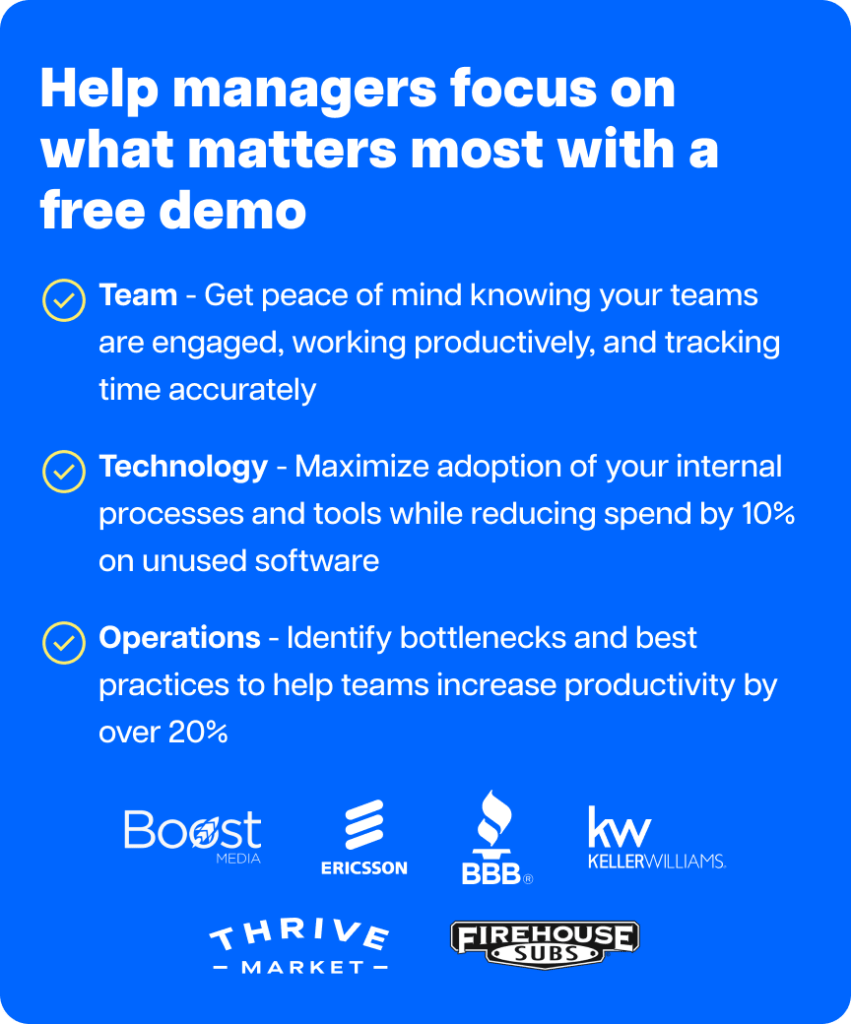How do you bring employees back to the office without compromising productivity or morale? Transitioning to an RTO (return-to-office) plan can feel like assembling a puzzle—every piece (employer needs, employee preferences, and operational efficiency) must fit perfectly.
An RTO plan isn’t just about logistics; it’s about striking the right balance to create a productive and fulfilling workplace for everyone involved. In this guide, we’ll explore what an RTO plan is, why it’s critical for your business, and how to create one that aligns with both employee satisfaction and organizational goals.

Table of Contents
- What is an RTO plan?
- Why employers prioritize RTO
- Common employee concerns about RTO
- Effective models for an RTO plan
- How to create and execute a successful RTO plan
What is an RTO plan?
An RTO (return-to-office) plan is a strategic framework designed to guide businesses in transitioning employees back to the office—whether fully or through hybrid arrangements. It’s more than just setting schedules; it’s about creating a balanced and effective workplace where collaboration, productivity, and employee satisfaction can thrive—whether in-office or during work-from-home arrangements.
A strong RTO plan considers:
- Business goals such as improving operational efficiency, rebuilding team culture, and fostering innovation.
- Employee needs like flexibility, work-life balance, and addressing concerns around commuting and well-being.
- Hybrid work challenges, including how to integrate remote work and in-office tasks seamlessly.
Think of it as a business continuity plan—a blueprint that ensures normal operations while aligning company objectives with the evolving future of work.
Part of this includes understanding recovery objectives, such as the recovery time objective (RTO) and the recovery point objective (RPO), to minimize disruptions.
- Recovery Time Objective (RTO): In business continuity, RTO refers to the maximum acceptable downtime after an unexpected disruption, such as a system failure, outage, or natural disaster. For return-to-office plans, RTO can also represent the time frame required to successfully transition employees back to in-office or hybrid environments without compromising business operations. A well-defined RTO helps organizations prioritize which tasks, systems, or teams need immediate attention to resume critical activities as quickly as possible.
- Recovery Point Objective (RPO): RPO focuses on the maximum amount of data loss a business can tolerate during a disruption. Defining clear service level agreements for data backup and replication ensures businesses can meet these recovery solutions efficiently. It is a key component of data backup and disaster recovery planning. In the context of RTO plans, RPO ensures that essential data—whether for employee workflows, IT systems, or project schedules—can be replicated and restored efficiently, minimizing delays and risks.
By addressing both RTO and RPO as part of the broader return-to-office strategy, businesses can create a seamless transition for employees while minimizing downtime, reducing data loss, and ensuring that systems and workflows remain intact.
Why employers prioritize RTO
An RTO plan isn’t just about bringing employees back to their desks—it’s about leveraging the benefits of in-person collaboration while addressing business needs. Here’s why RTO plans are a top priority:
- Improved collaboration: Remote work can limit creativity. According to a report from The Atlantic, companies like Amazon found that remote setups often result in fewer innovative ideas. Face-to-face interactions—whether during meetings or informal conversations—spark real-time brainstorming and problem-solving in ways virtual setups can’t replicate.
- Rebuilding culture: For younger employees, especially gen z, casual, unplanned in-person interactions—sometimes called “casual collisions”—are invaluable. These spontaneous moments foster mentorship, career development, mental health, and a sense of belonging. Most importantly, they help retain top talent because employees who feel connected are more likely to stay and grow within the company.
- Ensuring business continuity: Physical offices provide secure environments that remote setups often lack. For example, handling sensitive data, ensuring data protection or managing disaster recovery planning efforts is far more efficient in an office setting with a reliable IT infrastructure. Platforms like Microsoft Azure ensure data security and operational stability and reduce risks like data loss or downtime during an unexpected outage.

Common employee concerns about RTO
While RTO plans offer many benefits, employees often worry about the impact on their daily lives. These concerns need to be addressed to make the transition successful:
- Increased commute time and costs: Commuting can add stress and reduce personal time, and rising transportation costs only make it less appealing.
- Reduced work-life balance: Hybrid arrangements have allowed employees to balance work and personal responsibilities. Losing this flexibility could lead to longer workdays and challenges managing family commitments.
- Health, safety, and mental well-being: Some employees feel anxious about returning to the office, whether due to health concerns post-pandemic or the adjustment to in-person social interactions.
According to Mercer’s 2023 Inside Employees’ Minds Survey, 81% of employees were satisfied with their work-life balance under hybrid arrangements—a topic widely discussed on LinkedIn as companies navigate their return-to-office strategies.
. Most importantly, employers must acknowledge these concerns and offer solutions like flexible scheduling, wellness programs, and clear communication to ease the transition.
Effective models for an RTO plan
There’s no one-size-fits-all solution when it comes to RTO plans. The key is to find an approach that balances flexibility with productivity. Here are some models worth considering:
- Hybrid approach: Blend in-office and remote work. For example, designate specific days for collaboration and brainstorming in the office while reserving other days for remote-focused tasks.
- Voluntary or flexible return: Allow employees to choose whether to work remotely or in the office. This approach empowers employees and builds trust, which can increase job satisfaction.
- Project-based scheduling: Require in-office presence only for tasks or projects that need physical collaboration. For instance, an engineering team might come in for prototype testing but otherwise work remotely.
- Incremental RTO: Gradually increase office days over time to help employees adjust. Start with a few days a week and expand based on team feedback and needs.
Each model offers flexibility while aligning with business goals, making transitioning teams back to the office cost-effective and easier.
How to create and execute a successful RTO plan
A successful RTO plan goes beyond logistics; it’s about creating a strategy that prioritizes employee needs while meeting organizational goals. Here’s how to get it right:
- Assess readiness and gather feedback: Poll employees to understand their preferences and concerns while engaging senior management to align the plan with strategic goals. At the same time, evaluate business impact analysis results to ensure the RTO plan addresses challenges and opportunities.
- Choose the right model: Select an RTO model that aligns with your company’s industry, team size, and objectives.
- Prioritize communication: Set clear expectations for employees, including time frames, policies, and the reasoning behind the plan. Most importantly, create two-way communication channels to build trust and address concerns.
- Leverage technology to track success: Use tools like Time Doctor to monitor productivity, identify bottlenecks, and optimize workflows. For example, real-time data insights can help managers measure success and ensure normal operations.
- Stay adaptable and inclusive: Be prepared to adjust policies as needed to align with business continuity plans. Maintaining data backup and replication processes ensures systems are in place to support smooth operations during the transition.
Conclusion: How Time Doctor supports your RTO plan
As we step into 2025, businesses are rethinking their RTO strategies to balance business needs, collaboration, and employee satisfaction. A well-structured RTO plan fosters stronger teamwork, supports disaster recovery planning, and ensures operational stability during transitions.
Tools like Time Doctor quietly support these efforts. By offering real-time insights into productivity and highlighting inefficiencies, Time Doctor helps businesses minimize downtime and streamline workflows. Whether managing remote work or in-office schedules, these tools ensure that processes stay on track while supporting business continuity plans.
By combining a thoughtful RTO plan with technology and insights, businesses can successfully navigate the future of work, reduce risks like data loss, and create a connected, productive workforce.
Ready to make 2025 your most productive year yet? Visit Time Doctor to explore how it simplifies managing hybrid and in-office teams.

Liam Martin is a serial entrepreneur, co-founder of Time Doctor, Staff.com, and the Running Remote Conference, and author of the Wall Street Journal bestseller, “Running Remote.” He advocates for remote work and helps businesses optimize their remote teams.


